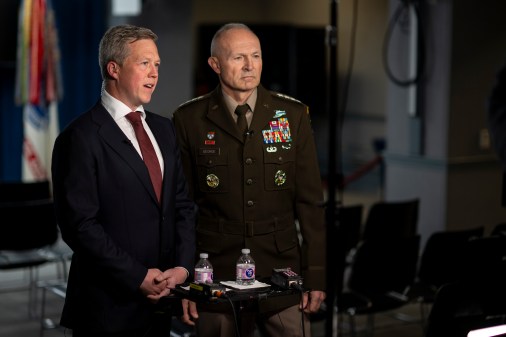Space Force reworking test, validation requirements to meet acquisition reform goals

As the Pentagon pushes for greater speed and agility in its acquisition processes, the Space Force is trying to find ways to relax the requirements for new systems, as well as cut down its test and validation timelines, according to service officials.
“We need to drive clarity and, maybe more importantly, simplicity in our system requirements, and then allow our acquisition professionals and the contractors maximum latitude to make trades and deliver quickly on systems that solve warfighter problems,” Chief of Space Operations Gen. Chance Saltzman said Thursday during an event hosted by the Center for Strategic and International Studies and the Hudson Institute.
The move to streamline requirements processes and reduce testing timelines comes as Secretary of Defense Pete Hegseth continues pushing the entire department to implement acquisition reforms that speed up capability delivery. In a Nov. 7 directive, Hegseth called on officials to remove unnecessary bureaucratic hurdles and revamp existing organizational structures to be more consolidated.
And while the Space Force has done some work to accelerate procurement timelines in recent years, Saltzman emphasized that more can be done to put new capabilities into the field more quickly.
One objective will be to give new Space Force “portfolio acquisition executives” — which will eventually replace traditional program executive officers — the authority to make trades in capability requirements when necessary. The goal is to move away from “fixed all-or-nothing” operational acceptance milestones and instead delivery capabilities in increments, Saltzman said.
“The goal is not to chase perfection in requirements or performance, but rather to deliver some capability incrementally, improving on what we have that can be ready quickly and then improve on that continually and use it operationally,” he said. “A capability that is good enough and ready now will always be better than a perfect solution that arrives too late for the fight, or one that never arrives at all.”
Agile procurement will also require the Space Force to evolve its testing and fielding framework to be more iterative, Saltzman added. The service currently follows a lengthy process to validate new systems before they are fielded, which can result in warfighters receiving outdated capabilities by the time they’re approved for delivery.
“We simply can’t wait for near perfection in our systems before putting them into operation. We can’t spend ages refining requirements before we start developing a new system. And we cannot add processes where it doesn’t add value. If we do, I think it will be too late,” Saltzman said.
However, the Space Force hasn’t quite nailed down exactly how to improve its test and operational acceptance frameworks that are used to discover potential risks for capabilities, Maj. Gen. Stephen Purdy, acting assistant secretary for space acquisition and integration, said Thursday during a panel at the event.
He emphasized that the entire Defense Department will need to find the right balance so that new systems — especially if they aren’t completely perfect — are actually beneficial to warfighers when delivered.
“We need to have a real discussion on the operator side and the requirements side, because these aren’t commercial entities — they’re warfighting systems, and there’s a joint warfighting force that has to produce guaranteed results,” Purdy said. “I want to deliver as fast as possible, but that’s going to produce less capable systems. We’ll be able to rev faster, but there’ll be risks there. There’ll be operational risk there, and there’s not a good answer to that question yet, so that’s going to be a hot moment of debate here going forward.”






